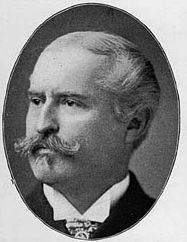Name Willis Hale | Role Architect | |
 | ||
Similar People Father Divine, William Strickland, John Haviland | ||
Willis Gaylord Hale (January 1848, Seneca Falls, New York – August 29, 1907, Philadelphia, Pennsylvania) was a late-19th century architect who worked primarily in Philadelphia, Pennsylvania. His flamboyant, highly-ornate style was popular in the 1880s and 1890s, but quickly fell out of fashion in the 20th century.
Contents
Life and career
According to the Biographical Album of Prominent Pennsylvanians (1890), Willis Hale became an architect through training in a series of offices: "His preliminary education was obtained at the academy at Seneca Falls, Cayuga Lake Academy at Aurora, and at the Auburn High School, where he finished his schooling. While still a pupil he ran away to join the army, but was too young to be enrolled, and was compelled to forgo his patriotic resolve. After quitting school he was given the choice of a three years' course at Ann Arbor University to study engineering, or an opportunity to study architecture. His tastes inclining more to the latter profession he decided to adopt it, and began study in Buffalo, going later to Rochester, and finally to Philadelphia, where he entered the office of Samuel Sloan, and later had Mr. John McArthur, Jr. as his preceptor. In 1873 he established himself in business at Wilkes Barre, Pa. ; but the troubles in the coal regions caused such a depression in all kinds of business that he returned, on November 2, 1876, to Philadelphia, where he opened an office and met with almost immediate success."
Hale married a niece of chemical manufacturer William Weightman, the largest landowner in the city. Hale designed dozens of blocks of middle-class housing for Weightman, especially in North and West Philadelphia. His lively facades often contrasted sculpture, tile, inventive brick- and stone-work, in an exuberant high-Victorian style: "Hale's genius was to take ... essentially identical rowhouses, with their mass-produced industrial parts and lathe-turned woodwork, and to make them distinctive." He designed a country house for Weightman in Germantown: "Ravenhill" (now part of Philadelphia University).
He also designed urban developments for street-car magnates Peter A. B. Widener and William L. Elkins, and a massive city house for Widener at the corner of Broad Street and Girard Avenue.
Widener's city house was one of the most notable in Philadelphia. An ornate Flemish-style eclectic design in highly-wrought brownstone and brick, it had a 53-foot (16.2 m) facade on Broad Street and a 144-foot (43.9 m) facade on Girard Avenue. The over-the-top interiors were decorated by George Herzog, and included buxom nudes as newel posts, walls embellished with alabaster and bronze, and murals of the Widener children in Renaissance dress. Almost an anachronism when completed in 1887, the family lived there only a dozen years before building a sedate neo-Georgian palace in the suburbs: Lynnewood Hall. The city house served as a branch of the Free Library of Philadelphia, 1900–1946; the offices of an architectural firm, and in 1970 became the Conwell School of Theology's Institute for Black Ministries. It suffered a catastrophic fire in 1980, and was demolished.
In 1892, Hale designed the Lorraine Apartment House at Broad and Fairmount Streets in Philadelphia, completed in 1894. Purchased by radio evangelist Father Divine in 1948, the building is now known as the Divine Lorraine Hotel.
Hale designed numerous ornate office buildings in Center City Philadelphia, but few survive unaltered. He built his own office building at the southwest corner of Chestnut and Juniper Streets (1887, expanded 1892, altered), an unsuccessful investment that almost bankrupted him. The critic for the magazine Architectural Record declared it an "architectural aberration":
"Consider the Hale Building, how it grows. The problem was to erect a seven-story office building with a narrow front on the principal street, and with rooms devoted to similar purposes and of similar dimensions throughout. The danger was that this uniformity would produce monotony. There is nothing of which your Philadelphia architect is so afraid as of monotony. In fact it is the only architectural defect of which he seems to go in fear. Variety he must have at all cost, and by securing variety he makes sure that he has avoided monotony, whereas in truth his heterogeneousness is more tiresome than any repetition could be. ...[E]very precaution has been taken, and with success, to insure that the building shall lack unity, shall lack harmony, shall lack repose and shall be a restless jumble."
Hale's architectural office was destroyed in a March 23, 1896 fire. He was a near-pauper in his later years, supported by the ever-loyal Weightman. He is buried just outside Philadelphia, in Fernwood Cemetery in Lansdowne, Pennsylvania.
A portfolio of photographs of Hale's work is at the American Philosophical Society.
Frank Furness
Hale is sometimes compared to his Philadelphia contemporary Frank Furness, who he admired. But Hale's buildings tended to be derivative and decorative rather than innovative, half-a-decade behind the times rather than ahead of them, more concerned with surface ornament than ideas:
"Hale's later fate was exemplary for the followers of Furness. For them, style was an affair of specacular massing, audacious surfaces, and whimsical detail. ... Their walls were always more clever than their plans; when they were forced to change brick and brownstone arches for marble cornices, as the tastes of the nineties demanded, the new work showed seams. Overdone and uncertain at the same time, Hale's last works were execulted for one or two loyal clients from the eighties."
Noted Lancaster, Pennsylvania architect C. Emlen Urban (1863–1939) worked under Hale in the early 1880s.
